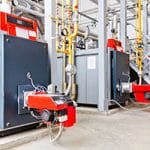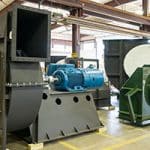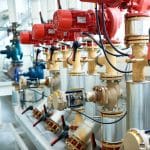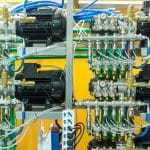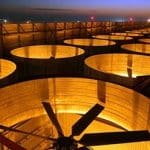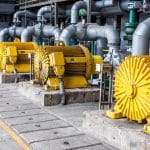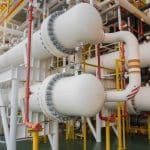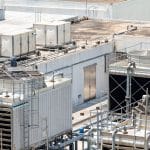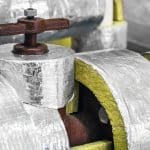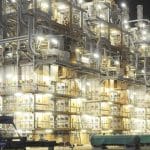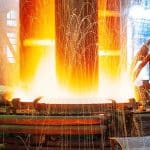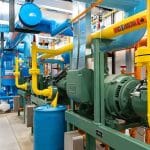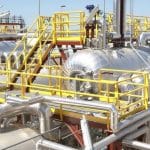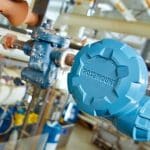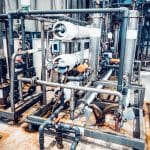The 3 kEys
- The way fluids move within a heat exchanger plays a fundamental role in determining its overall efficiency. By carefully managing flow patterns and selecting the right configuration, facilities can significantly improve performance without major capital investment.
- Baffles are one of the most effective additions to a heat exchanger’s design, as they help direct fluid flow, preventing the formation of dead zones where heat stagnates and reduces efficiency.
- Boost heat exchanger efficiency by increasing the available surface area for heat transfer. Heat exchangers rely on direct contact between fluid and metal surfaces to transfer thermal energy, so increasing this contact area enhances performance.
Industrial heat exchangers are pivotal in optimizing energy efficiency across various industrial business sectors, by facilitating effective heat transfer between fluids. Whether in manufacturing, food processing, or any other energy-intensive industry, maintaining their operational efficiency can lead to significant energy savings with minimal investment. Many Facilities Managers assume that improving heat exchanger performance requires capital-intensive upgrades, but the reality is that several low-cost strategies can substantially enhance efficiency.
Preventive Maintenance
One of the most critical aspects of heat exchanger efficiency is regular maintenance and cleaning. Over time, fouling—the accumulation of deposits such as scale, biological growth, or particulates—impairs heat transfer efficiency and increases energy consumption. Implementing a structured cleaning and maintenance schedule is essential to mitigate these effects. Studies have shown that regular cleaning not only enhances heat exchanger performance but also extends equipment lifespan by reducing the corrosive impacts of fouling. For help on this, take a look at our suggested maintenance regime at “Unlocking Efficiency: A Comprehensive Guide to Maintaining Industrial Heat Exchangers”.
Optimizing Flow Configuration to Maximize Heat Transfer Efficiency
The way fluids move within a heat exchanger plays a fundamental role in determining its overall efficiency. Many industrial systems operate with less-than-optimal flow configurations, leading to unnecessary energy losses and diminished heat transfer effectiveness. By carefully managing flow patterns and selecting the right configuration, facilities can significantly improve performance without major capital investment.
One of the most effective ways to enhance heat exchanger efficiency is by utilizing a counterflow configuration instead of a parallel flow setup. In counterflow arrangements, the hot and cold fluids move in opposite directions, maintaining a greater temperature gradient across the heat exchanger. This design allows for more effective heat transfer because, at any given point, there is always a significant temperature difference between the two fluid streams. In contrast, in parallel flow setups—where both fluids travel in the same direction—the temperature difference diminishes more rapidly along the exchanger, limiting its ability to transfer heat efficiently.
Maximized Temperature Gradient. Maintaining a higher temperature difference between hot and cold fluids throughout the exchanger directly improves thermal efficiency. Counterflow arrangements prevent the rapid equalization of temperatures seen in parallel flow systems, allowing the exchanger to extract or dissipate heat more effectively.
Minimized Energy Losses. Optimizing fluid flow patterns can also reduce pressure drop, which is a key factor in energy consumption. If fluids encounter excessive resistance due to poor design, pumps must work harder to maintain flow, consuming more energy. Properly managing turbulence and minimizing obstructions can significantly cut down on these unnecessary energy costs.
Enhanced Heat Transfer Coefficients. The introduction of specialized flow patterns, such as spiral flow or helical flow, can further enhance efficiency by improving fluid dynamics within the exchanger. These configurations promote turbulent flow, which enhances mixing and prevents the formation of stagnant boundary layers that can insulate surfaces and reduce heat transfer rates. See ResearchGate’s Heat Exchangers in Industrial Applications: Efficiency and Optimization Strategies for a white paper chock full of information you can use this afternoon.
Enhancing Turbulence and Preventing Stagnation with Baffles and Flow Directors
Baffles are one of the most effective additions to a heat exchanger’s design. These internal structures help direct fluid flow, preventing the formation of dead zones where heat stagnates and reduces efficiency. Without baffles, certain areas of the heat exchanger may experience laminar flow, where the fluid moves in smooth layers with little mixing. Laminar flow significantly limits heat transfer rates because only the fluid in direct contact with the heat exchanger surface contributes to thermal exchange.
By introducing baffles or flow directors, turbulence is increased, forcing the fluid to mix and distribute heat more effectively. This enhances the heat transfer coefficient, leading to more efficient thermal performance. Additionally, baffles help regulate residence time, ensuring that the fluid remains in contact with the heat transfer surface long enough to achieve optimal thermal exchange. Take a look at MDPI’s Optimization Design and Performance Study of a Heat Exchanger for some ideas on this and other issues.
It’s crucial to design baffles correctly—excessive use can cause excessive pressure drop, leading to increased pumping energy requirements. By using computational fluid dynamic (CFD) simulations or empirical testing you can help determine the ideal baffle arrangement for a given application.
Utilizing Finned Tubes and Corrugated Plates for Increased Surface Area
One of the simplest ways to boost heat exchanger efficiency is by increasing the available surface area for heat transfer. Heat exchangers rely on direct contact between fluid and metal surfaces to transfer thermal energy, so increasing this contact area enhances performance.
Finned tubes are widely used in air-cooled and shell-and-tube heat exchangers. These tubes feature metal fins that extend outward, dramatically increasing the surface area exposed to air or fluid. More surface area means more heat exchange occurs within the same physical footprint, making finned tubes an excellent choice for compact systems.
Corrugated plates, commonly found in plate heat exchangers, serve a similar function. The ridged or wavy surface increases turbulence and heat transfer efficiency by ensuring that fluid flows across a larger area. These plates also prevent scaling and fouling buildup by maintaining turbulent conditions that reduce sedimentation.
Both finned tubes and corrugated plates provide a cost-effective means to improve efficiency without requiring major equipment overhauls.
Material Selection and Thermal Conductivity
Copper and aluminum alloys are among the most conductive materials used in heat exchangers. Copper boasts a thermal conductivity of approximately 413 W/mK, making it ideal for applications where efficiency is paramount. Aluminum, with a thermal conductivity of about 237 W/mK, is also favored for its excellent heat transfer capabilities and lightweight properties. Here’s a great article by Protolabs on this subject: Choosing the Right Material for Heat Exchangers
Stainless steel, while less conductive than copper and aluminum, offers high mechanical strength and excellent corrosion resistance due to its protective oxide layer. These properties make it suitable for heat exchangers that must withstand high temperatures, high pressure, and harsh environments.
Titanium is another material used in heat exchangers, known for its exceptional corrosion resistance and strength, though it has a lower thermal conductivity and comes at a higher cost.
Selecting the appropriate material can significantly impact energy efficiency, especially in industries dealing with corrosive fluids or extreme temperatures. By choosing materials with superior conductivity and suitable mechanical properties, facilities can reduce thermal resistance and enhance overall system performance.
Continuous Monitoring and Advanced Control Systems
Beyond material selection and regular maintenance, continuous monitoring and performance analysis are vital for sustaining energy efficiency in heat exchangers. Tracking key parameters such as temperature differentials and pressure drops enables early detection of performance declines. Implementing predictive and continuous heat exchanger monitoring helps optimize cleaning schedules, enhancing production and energy efficiency.
Spartan Controls has a pretty thorough explanation on their heat exchanger monitoring, here: Heat Exchanger Monitoring.
For greater precision, integrating advanced control systems like Distributed Control Systems (DCS) allows for real-time regulation of heat exchanger operations. These systems continuously monitor critical parameters—temperature, pressure, and flow rates—ensuring precise control and real-time adjustments to maintain optimal heat exchange efficiency. The implementation of DCS automation leads to increased productivity, reduced operational costs, and improved system longevity.
Waste Heat Recovery Strategies
Utilizing waste heat recovery is another impactful strategy, enabling facilities to capture and repurpose excess heat from industrial processes. Instead of allowing valuable energy to escape through exhaust streams, heat exchangers can transfer it to preheat incoming fluids, significantly reducing the need for additional heating. Several approaches make waste heat recovery an accessible efficiency booster:
Regenerative Heat Exchange. Employs a storage medium, such as ceramic materials, to temporarily hold heat and transfer it when needed.
Recuperative Heat Exchange. Utilizes fixed surfaces, like plates or tubes, to facilitate direct heat transfer between two fluid streams.
Heat Pipes. Specialized devices that efficiently transport heat with minimal losses, ideal for compact systems.
A study published by the American Council for an Energy-Efficient Economy (ACEEE) highlights multiple industrial facilities that have implemented waste heat recovery systems. These systems capture waste heat from processes and repurpose it to preheat water or other fluids, leading to energy cost savings ranging from 10% to 20% annually, with payback periods between 6 to 18 months.
Read it here: Industrial Waste-Heat Recovery: Benefits and Recent Advancements in Technology and Applications.
The Big Finish
Optimizing fluid flow configuration and implementing targeted design modifications are effective methods to enhance heat exchanger efficiency without significant capital expenditures. Adjusting flow patterns, particularly by adopting counterflow configurations and utilizing computational fluid dynamics (CFD) simulations, can markedly improve heat transfer while reducing energy losses. Simple modifications, such as installing baffles, increasing surface area with finned tubes or corrugated plates, and selecting materials with high thermal conductivity, further contribute to improved energy performance.
These cost-effective strategies offer a practical approach to boosting industrial energy efficiency, lowering operating costs, and extending equipment lifespan.




